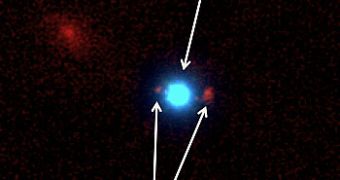The discovery of a quasar in a distant galaxy acting like a magnifying lens has thrilled astronomers. They searched the Sloan Digital Sky Survey (SDSS) quasar spectra database, hoping to find a case of reversed quasar-galaxy gravitational lensing. The perfect candidate was quasar SDSS J0013+1523, at 1.6 billion light-years away from the Earth. The 10 meters telescope of the W. M. Keck Observatory established that the quasar was magnifying a 7.5 billion light-years away galaxy and so gave scientists their first case of galaxy-magnifying quasar.
Einstein's theory of relativity says that if a large mass is located along the line of sight to a faraway galaxy, the light coming from it will split, allowing the observation of two or more close images of this magnified background galaxy.
The first case of gravitational lens, that gave images of a distant quasar, magnified and split by a foreground galaxy, was discovered in 1979. Since then, hundreds of cases were observed but astronomers wandered one thing: could this process work the other way round? The question got its answer from astronomers at the California Institute of Technology (Caltech) and Ecole Polytechnique Fédérale de Lausanne (EPFL) in Switzerland.
Quasars are very bright objects in the distant universe, powered by black holes containing millions of dying stars, in the middle of galaxies. Being so big and luminous, makes the galaxy's study very difficult. The lead author of the paper, Frédéric Courbin of EPFL, says: "It is a bit like staring into bright car headlights and trying to discern the color of their rims." by using gravitational lens "we now can measure the masses of these quasar host galaxies and overcome this difficulty," he added.
This method was suggested in 1936 by Fritz Zwicky, Caltech astrophysicist, and it gave good results in past years. Still it is the first time that researchers will use it to measure the mass of a quasar host. Georges Meylan, professor of physics and leader of the EPFL team says that they were thrilled that this idea can actually work. “This discovery demonstrates the continued utility of gravitational lensing as an astrophysical tool,” he stated.

 14 DAY TRIAL //
14 DAY TRIAL //